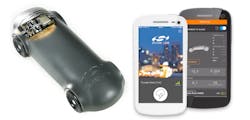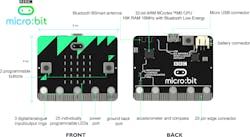Silicon Labs’ Thunderboard React (Fig. 1) is an IoT platform targeted at developers ranging from students to maker pros. It compares well with the micro:bit that was developed by the BBC for computer education in the United Kingdom. The Thunderboard React module sports a Cortex-M4, while the micro:bit runs a Cortex-M0.
The ThunderBoard is built around the Silicon Labs Blue Gecko BGM111 Bluetooth Smart Module, which has the 32-bit ARM Cortex-M4 processor, 256 Kbytes of flash memory, and 32 Kbytes of RAM. The Bluetooth transmit power is up to +8 dBm and the receive sensitivity down is –93 dBm. The board includes a coin cell battery on the back, making it a compact mobile device.
Peripherals include Silicon Labs’ Si7021 relative humidity and temperature sensor, Si1133 ambient light and UV sensor, and Si7201 omni-polar, hall-effect sensor, in addition to Invensense’s MPU-6500 6-axis motion sensor with an accelerometer and gyroscope. It has a pair of buttons and two LEDs.
If you are handy with a soldering iron, you can add an 8-Mbit serial flash. The breakout pins expose the BCM111’s GGPIO ports. The Thunderboard is available for $29 in single quantities.
The micro:bit (Fig. 2) has a Nordic Semiconductor nRF51822 for Bluetooth wireless support and a 48 MHz NXP/Freescale KL26Z. The peripherals include an NXP/Freescale MMA8652 3-axis accelerometer and MAG3110 3-axis magnetometer sensor, three buttons, and a 5×5 LED array. Power is supplied externally. It is priced under $15.
The micro:bit is designed to be programmed by students and is supported by an array of programming platforms, including graphical programming systems. The latter is not on par with something like National Instrument’s LabView because it is oriented towards new programmers. The board has an edge connector designed to plug into a socket if so desired. The LED array allows limited graphical feedback.
The micro:bit’s dual SoC system design allows the Bluetooth support to be locked down while providing complete access to the host processor. This approach is common even for embedded wireless solutions, but it is not necessarily the most cost-effective approach.
The Thunderboard’s single processor runs the Bluetooth stack, as well as the main application code. It comes with a demo application that links to an Android or Apple iOS app via Bluetooth. The smartphone app provides a link to Google’s Firebase cloud IoT platform called ThunderCloud. ThunderCloud uses the ReactJS framework.
The board is available alone, as a kit, or bundled with a pinewood derby car (Fig. 3). The Thunderboard was actually designed with this application in mind. The Si7201 hall-effect sensor is located on the outer edge of the board so the module can be mounted on the back of the car. A magnet is glued to the inside of one wheel so it can be tracked by the sensor. This provides interesting feedback that can be recorded in the cloud.
The demo application allows the module to be used without additional programming. The jump to a programming platform for the Thunderboard is more in line with advanced programmers versus an introduction that the micro:bit provides. It is designed to be programmed using Silicon Labs’ Simplicity Studio or IAR’s Workbench, using the Wireless STK hardware development platform that plug into the header on the back of the module (Fig. 4). The software makes use of the latest Bluetooth Smart C-SDK.
So, the number of users racing the car who will take up programming the module is likely to be small. On the other hand, developers looking to take advantage of Silicon Labs’ hardware and IoT support will find the module to be a compact, highly functional development platform. It is easy to develop for–comparable to most Bluetooth platforms.
The Thunderboard React board’s User Manual is quite extensive. It addresses the system and how it can be linked to the smartphone apps and ThunderCloud. The second half of the document addresses Simplicity Studio and its operation with the board. I haven’t had a chance to check out the hardware programming aspects at this point, although I have used Simplicity Studio in the past. The Eclipse-based platform is a well-proven development environment for IoT and non-IoT application development.
Although the Thunderboard React and micro:bit can be used by novices, the Thunderboard React is really the platform of choice for embedded developers. Developers who can use the hardware as-is in conjunction with the demo software may do their programming at the smartphone app level, or else in the cloud (Fig. 5).
The Thunderboard React does not have to utilize Silicon Labs’ software to communicate with the cloud, but it provides an infrastructure that can be utilized if desired. If not, the development tools and Bluetooth stack are available to developers who can then turn to third parties for IoT frameworks, or utilize one they develop. The Cortex-M4 has sufficient headroom to handle complex applications. Programming will be a bit more complicated, because developers need to take power utilization and communications into account, but that is what they get paid for.
It will be interesting to see what is built using Silicon Labs’ Thunderboard React.
About the Author
William G. Wong
Senior Content Director - Electronic Design and Microwaves & RF
I am Editor of Electronic Design focusing on embedded, software, and systems. As Senior Content Director, I also manage Microwaves & RF and I work with a great team of editors to provide engineers, programmers, developers and technical managers with interesting and useful articles and videos on a regular basis. Check out our free newsletters to see the latest content.
You can send press releases for new products for possible coverage on the website. I am also interested in receiving contributed articles for publishing on our website. Use our template and send to me along with a signed release form.
Check out my blog, AltEmbedded on Electronic Design, as well as his latest articles on this site that are listed below.
You can visit my social media via these links:
- AltEmbedded on Electronic Design
- Bill Wong on Facebook
- @AltEmbedded on Twitter
- Bill Wong on LinkedIn
I earned a Bachelor of Electrical Engineering at the Georgia Institute of Technology and a Masters in Computer Science from Rutgers University. I still do a bit of programming using everything from C and C++ to Rust and Ada/SPARK. I do a bit of PHP programming for Drupal websites. I have posted a few Drupal modules.
I still get a hand on software and electronic hardware. Some of this can be found on our Kit Close-Up video series. You can also see me on many of our TechXchange Talk videos. I am interested in a range of projects from robotics to artificial intelligence.







